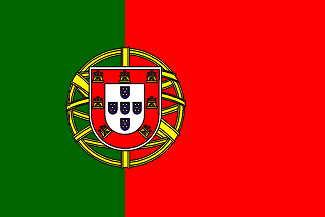

Wednesday 23 May 2001
After a very elaborate breakfast buffet at the Pousada we head for Viseu, a town in the Beira Alta province. The region has not yet been "discovered" by foreign tourists. Most of the major roads are good (motorways even excellent), but minor roads are quite bad with potholes all over. Viseu is none too big a town, with a few memorable sights. We stay at the Avenidahotel near the central Rossio square. In the late afternoon we set out to explore the town. In the middle of the day it was simply too hot with temperatures rising to 35°C. The cathedral is strictly Romanesque on the outside but has seen some redecoration in the 17th century. It has a nice cloister. The old town is a collection of narrow streets with the Via Direita (main street) as its main artery. Also Viseu is in the midst of a major overhaul of streets and buildings, all part of a major government programme to revitalise the inner cities. In Viseu too (and in most other cities too as we soon find out) there is a big billboard with clock counting down the days and hours left until the completion of the works.
In the evening we have dinner in the Churasqueria (=grill) da Sé, near the cathedral. It is a bit disappointing. We have coffee at the theatre café, a favourite haunt of the local youth. In our room we watch the Champions League finals between Bayern Munich and Valencia.
Thursday 24 May 2001
Despite the fact that it is Asuncion day, everybody is working as usual.
Shops are open like any other day. After breakfast we drive East towards
Gouveia. This small village is one of the gateways
to the national park of "Serra de Estrela". This mountain region is a
protected nature reserve (at least beyond 1200 metre above sea level) with the
highest mountains of Portugal. The Turismo of Gouveia is not very well equipped.
They can’t even supply us with a reasonably accurate map of the area. We
decide to go at it without one. The road into the area rises slowly but surely
and the temperature drops accordingly. The views are magnificent and far
reaching. Around 1 ‘o clock we reach the Pousada
(São Lourenço) of Manteigas. This is a modern Pousada, on a mountain
top. We stop here for a superb lunch. After that we continue uphill and make a
few short walks. We move on to Seia (mountain sport resort) where we sit down
for a drink. After that we return to Viseu.
At night we have a delicious meal at O Cortiço. The restaurant serves delicious blood sausages as hors d’oevre. As a main course we have duck and veal medallion. We end the evening with coffee in the theatre café.
Friday 25 May 2001
Today we drive on to Coimbra, in the Centro
region, an 80 km drive. Having arrived there is a bit of a puzzle finding
our way to the Pension Pombal, It is a simple guesthouse in one of the
narrow streets of the upper part of the old town. It is run by three Dutch
women. From the guest house we walk down hill into town. Downtown we sit down at
a side walk café for drinks and taking in the crowds, before we have a look at
the cathedral. It is yet another robust Romanesque building (unfortunately
partly hidden by scaffolding). Construction started in 1162, and centuries
past did not change much of its style. Lunch is at O Trovador, a fine
restaurant on the cathedral square. After lunch we have ourselves a little
siesta. Not a luxury with temperatures rising over 35°C. After our break we
find ourselves an internet café to send some messages home.
From the internet café we walk to the old university buildings. Coimbra has the oldest university in the country and the large. It is a fairly big one and its presence is felt in this medium sized town. The university was founded in 1290 and until early 20th century the only one in the country. The main building is around the Patio de Escolas, a square dominated by the clock tower, nicknamed "A Cabra" (the goat) and a statue of king John III. The Sale dos Capelos is open to visitors. It is an assembly room, where all dissertations and official ceremonies take place. Also open is the chapel – one of Coimbra's finest. The best attraction however is the old library, Biblioteca Joanina, a baroque present of king John V to the university dating back to the 18th century. It is a magnificent piece of woodwork covered with gold leaf. The valuable titles have been moved elsewhere. The books on display were chosen for their looks. Most other university buildings are quite ugly, but the view from the university hill over town is very nice indeed.
At night we walk downtown again. We have a pre-dinner drink (white port!) on
the Santa Cruz square
at the Café Santa Cruz. Beautiful interior and an attractive side walk
café besides the church with a view overlooking the square and the main
shopping street. We have dinner in the simple eatery Adega Paço de Pedro.
The only waitress runs up and down the place that is too big for her to handle.
We want to go to Diligência, the place to be for Fado-music in Coimbra.
Fado is the famous Portuguese musical tradition with songs full of passion and
sorrow. Both Coimbra and Lisbon are noted for their numerous clubs and bars
where fado is being sung. Nine thirty is a bit early, so we have some time to
kill. After eleven we head for Diligência . The place does not have any
programmed performances. Regulars who feel like it and have the talent, grab
their guitar and start singing their song. We are lucky to hear one them giving
a great performance.